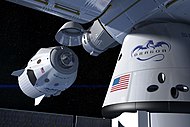SpaceX Crew-8
| SpaceX Crew-8 | |||
 | |||
| Statistik för uppdraget | |||
|---|---|---|---|
| NSSDC-ID | 2024-042A[1] | ||
| Modell | Dragon 2 | ||
| Beställare | NASA | ||
| Operatör | SpaceX | ||
| Farkostens namn | Endeavour (5) | ||
| Varaktighet | 235 dag, 3 tim, 35 min | ||
| Uppskjutning | |||
| Raket | Falcon 9 Block 5 | ||
| Uppskjutningsramp | Kennedy LC-39A | ||
| Uppskjutning | 4 mars 2024, 03:53 UTC[2] | ||
| Landning | |||
| Landning | 25 oktober 2024, 07:29:02 UTC | ||
| Landningsplats | Mexikanska golfen | ||
| Omloppsbana | |||
| Varv runt jorden | 3 760 st | ||
| Grader | 51,6° | ||
| Dockning | |||
| Rymdstation | ISS | ||
| Dockning | 5 mars 2024, 07:28 UTC | ||
| Port | PMA-2/IDA-2 (Harmony, fram) | ||
| Ur dockning | 2 maj 2024, 12:57 UTC | ||
| Andra dockningen | 2 maj 2024, 13:46 UTC | ||
| Port | PMA-3/IDA-3 (Harmony, zenit) | ||
| Andra ur dockning | 23 oktober 2024, 21:05 UTC | ||
| Tid dockad | 232 dag, 11 tim, 16 min | ||
| Besättning | |||
| Befälhavare | Matthew Dominick (1) | ||
| Pilot | Michael R. Barratt (3) | ||
| Uppdragsspecialister | Jeanette J. Epps (1) Alexander Grebenkin (1) | ||
| Kronologi | |||
| |||
SpaceX Crew-8 är uppdragsbeteckningen för en bemannad rymdfärd med en Dragon 2-rymdfarkost från SpaceX. Farkosten sköts upp med en Falcon 9-raket från Kennedy Space Center LC-39A den 4 mars 2024. Flygningens destination är den Internationella rymdstationen (ISS).[2]
Farkosten dockade med rymdstationen den 5 mars 2024.
För att ge plats åt Boeing Crewed Flight Test flyttades farkosten från en dockningsport till en annan dockningsport, den 2 maj 2024.
På grund av problem som uppstod under Boeing Crewed Flight Test, tjänstgjorde Dragon farkosten som livbåt för ytterligare två astronauter, mellan den 6 och 29 september 2024. De båda lämnades kvar på rymdstationen då deras CST-100 Starliner återvände till jorden obemannad.
Farkosten lämnade rymdstationen den 23 oktober 2024, två dagar senare återinträdde den i jordens atmosfär och landade i Mexikanska golfen.
Besättning
| Befälhavare | Hans första rymdfärd |
|---|---|
| Pilot | Hans tredje rymdfärd |
| Flygingenjör 1 | Hennes första rymdfärd |
| Flygingenjör 2 | Hans första rymdfärd |
Backup
| Befälhavare | |
|---|---|
| Pilot | |
| Flygingenjör 1 | |
| Flygingenjör 2 |
Källor
- ^ ”NASA Space Science Data Coordinated Archive” (på engelska). NASA. https://nssdc.gsfc.nasa.gov/nmc/spacecraft/display.action?id=2024-042A. Läst 16 mars 2024.
- ^ [a b] ”NASA’s SpaceX Crew-8” (på engelska). NASA. 2 mars 2024. https://www.nasa.gov/event/nasas-spacex-crew-8-launch/. Läst 2 mars 2024.
| ||||||||||||||||||||||||||||||||||||||||||||||||||||||||
| |||||||||||||||||||||||||||||||
| ||||||||||||||||||||||||||||||||
Media som används på denna webbplats
Rotated and color enhanced version of original (ISS013-E-48788 (6 July 2006) --- The Space Shuttle Discovery approaches the International Space Station for docking but before the link-up occurred, the orbiter went through a series of inspection photos by station crew to inspect the vehicle for any damage to its Thermal Protection System. This was known as the Rendezvous Pitch Maneuver and was implemented after the Columbia Disaster in 2003. The Leonardo Multipurpose Logistics Module can be seen in the shuttle's cargo bay. Discovery docked at the station's Pressurized Mating Adapter 2 at 9:52 a.m. CDT, July 6, 2006.)
In this illustration, a SpaceX Crew Dragon spacecraft approaches the International Space Station for docking. NASA is partnering with Boeing and SpaceX to build a new generation of human-rated spacecraft capable of taking astronauts to the station and expanding research opportunities in orbit. SpaceX's upcoming Demo-1 flight test is part of NASA’s Commercial Crew Transportation Capability contract with the goal of returning human spaceflight launch capabilities to the United States.
Författare/Upphovsman: SpaceX, Licens: CC0
This artist's concept shows a SpaceX Crew Dragon docking with the International Space Station as it will during a mission for NASA's Commercial Crew Program. NASA is partnering with Boeing and SpaceX to build a new generation of human-rated spacecraft capable of taking astronauts to the station and expanding research opportunities in orbit.
Författare/Upphovsman: Pascal (Flickr user: pasukaru76), Licens: CC0
Vostok spacecraft replica at the Technik Museum Speyer, Germany.
Backdropped by a blue and white Earth, this close-up view features the Soyuz TMA-6 spacecraft approaching the International Space Station (ISS). Onboard the spacecraft are cosmonaut Sergei K. Krikalev, Expedition 11 commander representing Russia's Federal Space Agency; astronaut John L. Phillips, NASA ISS science officer and flight engineer; and European Space Agency (ESA) astronaut Roberto Vittori of Italy. The Soyuz linked to the Pirs Docking Compartment at 9:20 p.m. (CDT) on April 16, 2005 as the two spacecraft flew over eastern Asia. The docking followed Friday’s launch from the Baikonur Cosmodrome in Kazakhstan.
Författare/Upphovsman: Space Exploration Technologies Corp., Licens: CC0
The 2018 version of the Big Falcon Rocket at stage separation: Starship (foreground) and Super Heavy (background)
The official insignia of the SpaceX Crew-8 mission.
- Dragon Crew-8, composed of NASA astronauts Matthew Dominick, Michael Barratt, and Jeanette Epps, and Roscosmos cosmonaut Aleksandr Grebenkin, is ready to stand the watch on its mission to maintain a continuous human research presence in low-Earth orbit represented by the never-ending path of a Latin numeral 8 with the dragon bowing with respect to the destination, the International Space Station.












